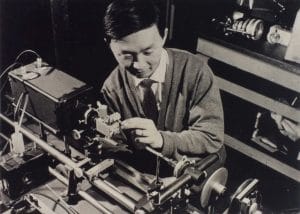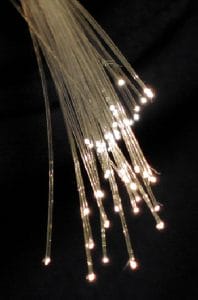Born in China, Kao went to school in Hong Kong, then moved to Britain for graduate school, earning his PhD in electrical engineering from the University of London. While still in school, he worked at the Standard Telecommunication Laboratories in Harlow, England. He was assigned to figure out why optical communications waveguides didn’t work well. His supervisor, Antoni Karbowiak, was convinced that thin-film optics was the way to go, but when Karbowiak left to take another job, Kao was put in charge of the project. He dropped work on thin-films and turned instead to what he thought would work better: fiber optics. But there was a problem. In 1965, Kao (with colleague George Hockham) determined that the theoretical attenuation — loss of signal — of a glass fiber should be below 20 dB/km (decibels per kilometer), but they were instead exceeding 1,000 dB/km — the signal was essentially zero after only 20 meters.

What was the problem? Kao’s breakthrough was his thought about what was causing the attenuation in optical waveguides: the properties of the glass fibers themselves, most notably the impurities in the glass. He not only figured out how to make the glass more pure to reduce attenuation (silica glass can be made with no other ingredients, he realized), he experimented with different lasers to send the optical information in the first place, as different optical wavelengths would work better depending on the dimensions of the fiber. In 1966, Kao and Hockham published what’s now considered a landmark paper: “Dielectric-Fiber Surface Waveguides for Optical Frequencies” — concluding that “a fibre of glassy material” that was properly made and sized “represents a possible practical optical waveguide with important potential as a new form of communication medium.” And that opened the floodgates of optical fiber communications.

“The word ‘visionary’ is overused, but I think in the case of Charles Kao, it’s entirely appropriate,” says John Dudley, a former president of the European Physical Society and himself a researcher in fiber optics. “He really did see a world that was connected, by light, using the medium of optical fiber. And I think society today owes him a great deal for that work.” Indeed so: “Communication as we know it, including the Internet, would not exist without fiber optics,” said William Wulf, president of the U.S.-based National Academy of Engineering. Fittingly, Kao is considered not just the “Father of Fibre Optics” but also the “Godfather of Broadband”. In 1983, he said oceans would be “littered” with fiber optic cables; it only took five years for the first transoceanic fiber to be lit up. Kao was knighted by the British Empire (CBE, 1993, and KBE, 2010), and awarded the Nobel Prize in Physics in 2009 for his “groundbreaking achievements concerning the transmission of light in fibers for optical communication” (shared that year with the inventors of the CCD — the digital camera chip). It was estimated at that time that 600 million miles of optical fiber was in use — much of it on the ocean floor. He became a citizen of the United States and worked there, as well as Japan, Hong Kong, and Britain. He died in Hong Kong on September 23, from Alzheimer’s disease. He was 84.
